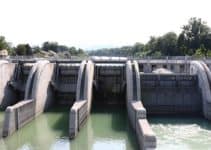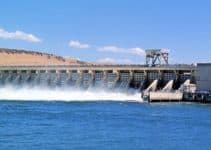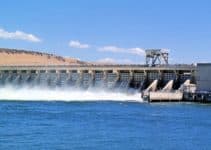Energy consumption makes up a big part of our daily lives. We use energy for numerous functions including heating, traveling, working, and even flirting. The question is; where does this energy come from? Today, most of our energy needs are met by fossil fuels including oil, coal and natural gas. We also get part of our energy from nuclear, biomass and renewables. While fossil fuels are the main source of our energy, they cost more at the pump and affect the environment in numerous ways. These effects include global warming, degradation of air quality, acid rain and oil spills. It’s also projected that these fossil fuel resources will be depleted in the next 50 to 100 years. Nuclear energy also comes with a host of problems including dangerous radioactive waste and nuclear radiation hazards. The solution squarely lies in renewable energy resources such as solar, wind, geothermal and hydropower. Of all the renewable sources of energy, hydropower is the largest and oldest power source in the world.
Hydropower is obtained by harnessing the kinetic energy of flowing water and converting it into electricity for a variety of home and commercial applications. It qualifies as a renewable energy since the water cycle is continually renewed by the sun. It is the largest source of electricity around the world accounting for more than 20% of the world’s electricity. Countries such as Canada, New Zealand, Brazil, Switzerland, Venezuela, and Paraguay generate majority of their electricity through hydropower. Hydropower was utilized as far back as ancient Greece by farmers for mechanical tasks such as powering watermills to grind grains. However, cheap electricity has made these watermills redundant in the modern day. Today, the largest hydropower plant in the entire world is the Three Gorges Dam in China.
Various Disadvantages of Hydroelectric Power
- Disrupts aquatic ecosystems
Hydropower plants are typically constructed across rivers, and this can interfere with aquatic life and result in their huge scale devastation. There is a huge probability that the fish or other river animals may find way into the penstock and eventually into the turbines where they will be exterminated. Construction of dams in specific places can interfere with the mating patterns, seasons and breeding areas of the water animals.
In some instances, these animals are left with no choice but to swim against the water stream when breeding season comes. In some occasions, dams are built in the path of migrating fish. This means their path to the feeding grounds is cut off leading to their deaths. This could drastically bring down the population of fish.
- Constructions needs a large area
To be able to construct a dam, install power production units, plus transformers, and tether them to the main grid requires a large piece of land. This may call for clearing of large chunks of forest to provide space for building the dam. Clearing of forest greatly impacts the natural ecosystems.
- Initial costs are significantly high
It’s generally expensive to build up a power plant, and hydropower plants are no exception. The average cost of building a small hydropower plant is $10 million. This figure takes into account the cost of construction per megawatt, which stands at $1 million. The large scale power plants can cost as much as $450 million dollars. The cost of a hydropower plant, in reality, hinges on the specific site than the cost of the power generation equipment.
The land ownership and water rights have to be ironed out, and this costs money. The size of the reservoir to be constructed massively adds up the cost. A massive reservoir will utilize lots of reinforced concrete, require construction of large tunnels in the bedrock on each side of the dam and necessitate the construction of new bridges and roads to get the dam construction materials to the site. This means the reservoir dam alone could cost between $10 to $200 million depending on the inaccessibility of the site and its distance from construction crews and materials.
The generated power has to be transmitted to the grid, and this means parting with hundreds of thousands of dollars per mile. In a nutshell, the logistics involved in building a hydropower plant alone may drive the costs further.
- Uproots human populations
Because construction of a dam takes up a large chunk of land, it forces relocation of humans. It’s almost an insurmountable challenge to convince individuals to uproot their lives including their businesses. In most instances, these people are never compensated adequately for their land and inconveniences caused. This always turns out to be chaotic with revolts and large-scale opposition against the dam construction.
A classic example of large scale opposition to dam construction is the hydropower project called ‘’Sardar Sarovar.” Though the project would have benefited millions of people, the government failed to address the critical aspect of resettlement after they were uprooted from the project site. This act resulted in the biggest protest in the history of India, which witnessed large numbers of protest marches, hunger strikes and gruesome police attacks on protesters.
- Requires high-quality construction materials
Materials to be used in the construction of the dam must be of uniquely high quality. No one wants to witness the repercussions of dam breakage. Dam breakage can lead to massive flooding, which can cause huge destruction to humans, animals, and plants. A typical example of dam failure is the Banqiao Dam in China that led to the death of over 171, 000 people. The aftermath of the tragedy left millions without homes.
- Impacts on environment
While hydropower plants don’t need any fuel, do not emit any greenhouse gasses and do not cause pollution directly, they do have some catastrophic effects on the environment. The activities involved in the construction of the dam disturb the environment to a greater degree.
When the natural course of the river is diverted, the areas nearby may become flooded, interfering with the natural flora and fauna. People living in those areas get uprooted. The vast bodies of water formed as a result of flooding also give off high amounts of greenhouse gasses such as carbon dioxide. This means that hydropower plants produce greenhouses gasses indirectly. Over the course of the dam construction, the number of vehicles making way into the dam construction site for unloading and loading also contributes to the emission of greenhouse gasses that directly impacts the animals and plant life in the nearby forest.
- Concerns about safety of the dams
The safety of the dam is paramount for the nearby population. In the modern day where acts of terror are rife, dams can be a major target to kill thousands of people. This is why after construction and fully operational, the dam has to be accorded maximum security. Security adds up the overall cost of constructing a hydropower plant.
- The risk of drought
Power generation and electricity prices are closely related to the amount of water available. A severe drought could impact this. When there is prolonged drought, rivers tend to dry up, which means no or less water for electricity generation. When this happens, power rationing becomes the order of the day and electricity prices shoot up.
- Geological damage
Construction of large-scale dams can contribute to grave geological damage. A classic example of geological damage is the construction of the Hoover Dam in the United States that caused earthquakes and led to the depression of the earth’ surface in the area.
While hydropower energy has some noted disadvantages, its advantages are far greater. It’s a renewable resource, which means it will never end, giving it a sense of reliability. Hydropower is also safe since it doesn’t involve combustion of fossils fuels. Although the initial costs of construction are high, the long-term benefits are immense including flexible and cheap source of electricity for many years.


